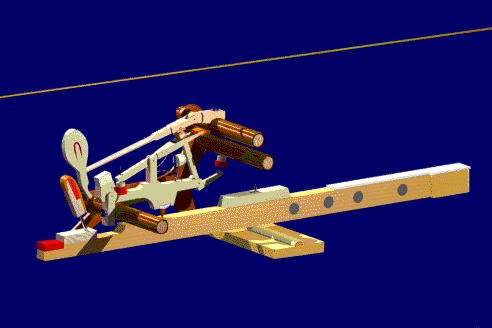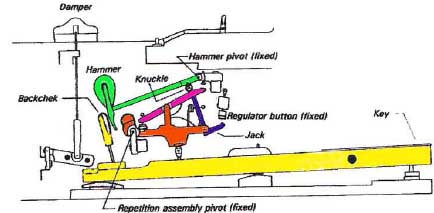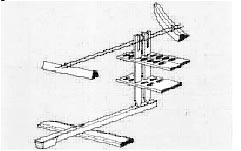What is the real meaning of word Action
How this device came about more than three hundred years ago.
Service technicians call Action the gears inside piano keyboard, what action means more precisely is a meaningful concept:
Action in physics terms is expressed as (Energy) (time) or (mass x lenght2 )/time

Bartolomeo Cristofori (Tuscany 1655 - 1732) inventor of pianoforte action was well known luthier constructor of spinets and harpsichords. He had the all new idea to make a device of hitting strings.
What's new in Cristoforis' system is no more a mechanic plectrum and a lever spinets and harpsichords action (see picture bellow). Old action does not permit to play legato. Instead the revolutionary Invention has a mechanical gear through which string receive energy impulse from bottom side, alike a pebble launch from a sling, that is to say, in opposition to gravity force. Therefore I'll assume Cristofori called his invention "Gravicembalo with-the-piano and with-the-forte" not only because comparing to its predecessors is a device more able to emit grave low bass sounds. The new action functionement is set up basically on gravity force, in other words on the weight. Not only the weight of gear elements to the gravitational force that makes the strings sound are involved, but also of the weight of the musician shoulder, arm, forearm, and hand. Pianist force that striking the key acts towards the center of the earth anyway. We can conclude the counterbalancing and equilibrium of such two weights at playing open a broad extensive availability of mechanical configurations to enrich artist expression. Gesture movements and harmonious sounds render possible to express infinite shapes of feelings and states of mind. Thanks Professor K. Wayne Land for such a a beatiful action animation.
Piano "Action" in Physics: Not the gears alone but an amount of mechanical energy that starts from player hand and flows in time through a gear mechanism towards the string. All this trasfering of energy is achieved in interaction with the gravity force. In a rather wide sense, acoustic pianoforte action is closely a gravitational instrument.
The invention of Bartolomeo Cristofori succeeded to overwhelm the demand of musicians, they not only wanted a new brand instrument with more depth of sound than clavicembals but other with more expressive dowries.
There are 74 components in the grand-piano action. Functionement and design of upright piano action is completely different. In all pianos action components are grouped in five main rigid body coupled elements (colored):

The evolution of this mechanism happened through some decades long metamorphosis, with important improvements made by other European inventors, among others Johann Andreas Stein who developed the Viennese action (1728-1792) in Germany, and Sebastian Erard (1752-1831) in France. Two patented standard double blow mechanism, so far in 1821. Upright piano action was invented by the italian priest Domenico Del Mela in 1739. There are pretty epoch images in this website hammerfluegel. Some chronology remarks are visible here .
This is a harpsichord action: plettro mechanism:

